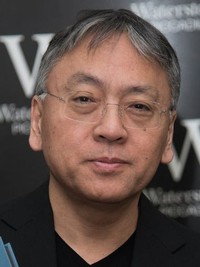Kazuo Ishiguro

Author Kasuo Ishiguro's novels, with their unique, familiar, yet oftentimes otherworldly settings, were praised not only by readers, but by some of literature's most prestigious institutions, including his Nobel Prize in Literature in 2017. Born in Nagasaki, Japan, Ishiguro relocated to the United Kingdom when he was five, when his oceanographer father began conducting research at the National Institute of Oceanography in Surrey. Ishiguro would attend primary and secondary school in England, and later went on to attend the University of Kent, where he received a bachelor's degree in English and Philosophy in 1978. Ishiguro had a longstanding interest in the arts, moving in social circles that participated in music, graphic art, and fringe theater. His own interest in music would find him writing and recording songs of his own, even submitting demo tapes to record labels during his youth. Eventually, however, Ishiguro would earn a master's degree in creative writing at the University of East Anglia. In 1982, he published his first novel, A Pale View of the Hills. During that same year, he became a British citizen. Though he was raised in Great Britain and would not revisit Japan until years later, Ishiguro would later note that his sense of identity was strongly colored by the Japanese culture of his family's home. Many critics praised the particular image of Japan depicted in Ishiguro's novels such as An Artist of the Floating World, and the author himself later observed that his own complex sense of nationhood and identity influenced the unique description of the nation that he constructed in his novels. Neither a precisely accurate portrayal of the country nor a completely fictitious one, Ishiguro's idea of Japan was, like much of his work, a product of his unique perspective as a person and as an author. In 1986, the young writer was working in Notting Hill at a West London homelessness charity when he met a social worker named Lorna MacDougall. They were soon married, and later gave birth to a daughter named Naomi. As the '80s wore on, he produced several more novels, including The Remains of the Day, published in 1989. The period story followed the unconsummated romance between a housekeeper and butler working at an estate in early-20th century England. The book was a smash both critically and commercially, winning the prestigious Booker Prize for literature. It was adapted into a prestigious feature film by Merchant Ivory Productions in 1993, starring Emma Thompson and Anthony Hopkins. Ishiguro finally returned to Japan for the first time since his childhood immigration as part of the Japan Foundation Short-Term Visitors Program in 1989. He continued to find success as the '90s progressed, notably being made an Officer of the British Empire in 1995, not long after the publication of his fourth novel, The Unconsoled. He followed this work with When We Were Orphans in 2000 and Never Let Me Go in 2005, both of which were shortlisted for the Booker Prize. 2005 also found Ishiguro penning an original screenplay for a period drama called "The White Countess" (2005), which was brought to the screen by James Ivory. For his 2015 novel The Buried Giant, Ishiguro explored perhaps his most complex themes yet as a storyteller, using a semi-historical, semi-fantastical setting to explore ideas about the nature of memory and perception. In 2017, Ishiguro was awarded the Nobel Prize in Literature.